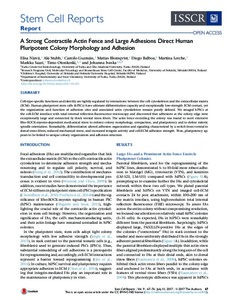A Strong Contractile Actin Fence and Large Adhesions Direct Human Pluripotent Colony Morphology and Adhesion
Timo Otonkoski; Aki Stubb; Diego Balboa; Matias Blomqvist; Martina Lerche; Camilo Guzmán; Elisa Närvä; Markku Saari; Johanna Ivaska
https://urn.fi/URN:NBN:fi-fe2021042716976
Tiivistelmä
Cell-type-specific functions and identity are tightly regulated by
interactions between the cell cytoskeleton and the extracellular matrix
(ECM). Human pluripotent stem cells (hPSCs) have ultimate
differentiation capacity and exceptionally low-strength ECM contact, yet
the organization and function of adhesion sites and associated actin
cytoskeleton remain poorly defined. We imaged hPSCs at the cell-ECM
interface with total internal reflection fluorescence microscopy and
discovered that adhesions at the colony edge were exceptionally large
and connected by thick ventral stress fibers. The actin fence encircling
the colony was found to exert extensive Rho-ROCK-myosin-dependent
mechanical stress to enforce colony morphology, compaction, and
pluripotency and to define mitotic spindle orientation. Remarkably,
differentiation altered adhesion organization and signaling
characterized by a switch from ventral to dorsal stress fibers, reduced
mechanical stress, and increased integrin activity and cell-ECM adhesion
strength. Thus, pluripotency appears to be linked to unique colony
organization and adhesion structure.
Kokoelmat
- Rinnakkaistallenteet [19207]
